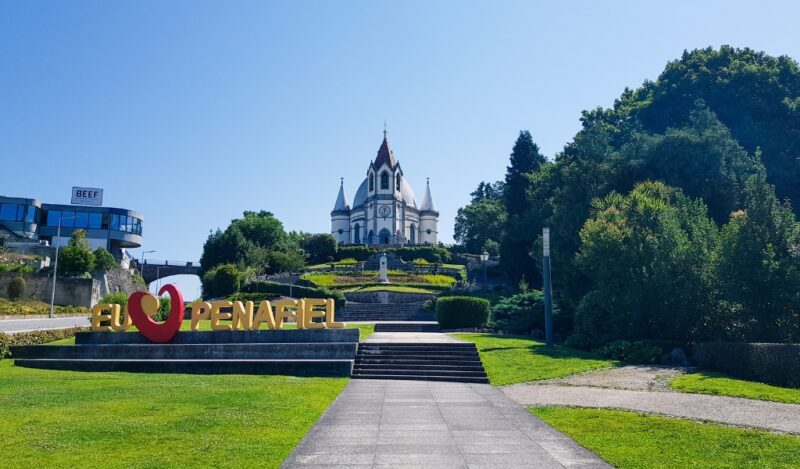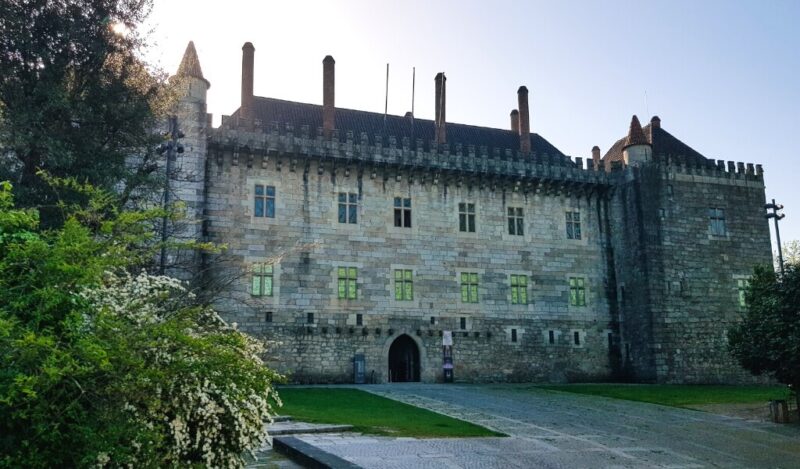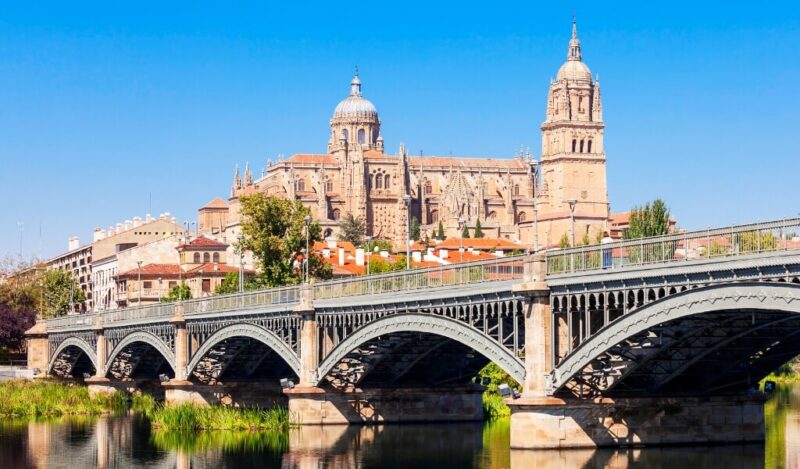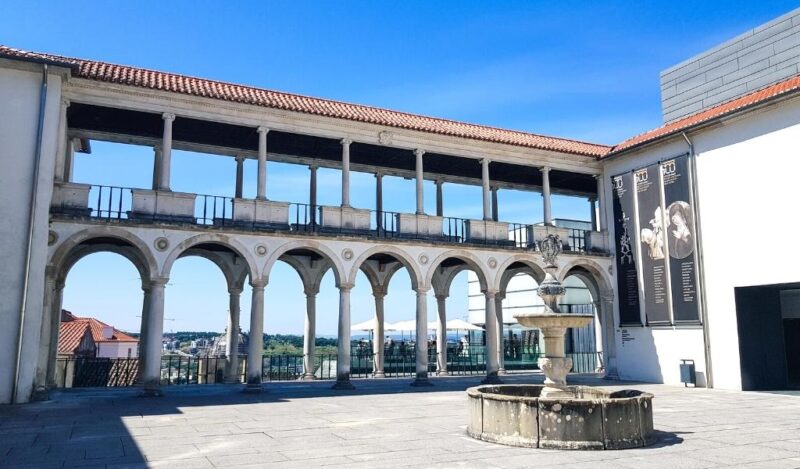The Quinta da Regaleira in Sintra is a must-visit monument for all lovers of architecture, landscaping, and even… mysticism! By the way, did you know that the property hides mystical structures, magical sceneries, and alchemical symbols linked to Freemasonry, the Templars, and the Rosicrucian Order?
Built at the end of the 19th century a few meters from the historic center of Sintra, the Quinta da Regaleira is made up of a luxurious palace (the Palace of Regaleira) and an enigmatic garden (the Garden of Regaleira), which reflect the interests and ideologies of its first owner: the Portuguese-Brazilian millionaire António Augusto de Carvalho Monteiro!
So, do you want to know more about the Quinta Da Regaleira In Sintra: Best Tips For Visiting In 2024? Keep reading!
This post may contain affiliate links, meaning I earn a small commission if you make a purchase, at no additional cost to you. Please read my disclosure & privacy policy for more information.
No time to read now? Pin it for later!


- Brief History of the Quinta da Regaleira in Sintra
- How to Get to the Quinta da Regaleira in Sintra
- What to See at the Quinta da Regaleira in Sintra
- More Posts about Portugal
- More Posts about Castles and Palaces
- More Posts about Gardens and Parks
- More Posts about World Heritage
- What Photography Gear Do I Use?
Brief History of the Quinta da Regaleira in Sintra
In the second half of the 19th century, the Portuguese town of Sintra became one of the main centers of romantic architecture in Europe. And it was precisely in these decades that some of the historic buildings, which form part of the so-called “Cultural Landscape of Sintra” (declared a UNESCO World Heritage Site in 1995), emerged.
Park and National Palace of Pena, Park and Palace of Monserrate, Garden and Chalet of the Condessa of Edla, Villa Sassetti, Quinta da Regaleira… The list goes on when it comes to architectural and landscape masterpieces designed during this period!


António Augusto de Carvalho Monteiro (1848-1920) was the heir to a large family fortune in Brazil. Known by the nickname “Monteiro of the Millions”, he distinguished himself as an art collector, bibliophile, entomologist, and philanthropist.
Carvalho Monteiro bought the Quinta da Regaleira in Sintra in 1892, after having passed through several owners since the end of the 17th century. Work began a few years later and the design of the Palace and Garden was in charge of the Italian Luigi Manini (1848-1936).
Manini had made a career as a set designer at the Teatro alla Scala (in Milan, Italy) and the Royal Theater of São Carlos (in Lisbon, Portugal), but he was an equally brilliant architect. In addition to the Quinta da Regaleira in Sintra, he was responsible for the Royal Palace of Bussaco (now Bussaco Palace Hotel), built at the same time.
World Heritage
Did you know that the Quinta da Regaleira in Sintra was part of Portugal’s fourth set of inscriptions on the UNESCO World Heritage List in Portugal? This 19th session of the World Heritage Committee took place in Berlin (Germany), between December 4th and 9th, 1995.
However, the Cultural Landscape of Sintra includes many other UNESCO World Heritage Sites besides the Quinta da Regaleira, such as the Chalet of the Countess of Edla, the Convent of the Capuchos, the Moorish Castle, the National Palace of Pena, the National Palace of Sintra, the Palace of Monserrate, and the Villa Sassetti, among others.
Nowadays, Portugal is the ninth country in Europe and the eighteenth country in the world with the most UNESCO sites, tied with Czechia and Poland. It has seventeen heritage assets (both cultural and natural) inscribed on the world list of the United Nations Educational, Scientific, and Cultural Organization.
In the meantime, I’ve already had the opportunity to visit fourteen of them:
- Alto Douro Wine Region (2001)
- Convent of Christ in Tomar (1983)
- Cultural Landscape of Sintra (1995) – Chalet of the Countess of Edla, Convent of the Capuchos, Moorish Castle, National Palace of Pena, National Palace of Sintra, Palace of Monserrate, Quinta da Regaleira, Villa Sassetti
- Garrison Border Town of Elvas and its Fortifications (2012)
- Historic Center of Évora (1986)
- Historic Center of Guimarães and Couros Zone (2001, 2023)
- Historic Center of Porto, Luiz I Bridge, and Monastery of Serra do Pilar (1996)
- Monastery of Alcobaça (1989)
- Monastery of Batalha (1983)
- Monastery of the Hieronymites and Tower of Belém in Lisbon (1983)
- Prehistoric Rock Art Sites in the Côa Valley (1998, 2010)
- Royal Building of Mafra – Palace, Basilica, Convent, Cerco Garden, and Hunting Park (Tapada) (2019)
- Sanctuary of Bom Jesus do Monte in Braga (2019)
- University of Coimbra – Alta and Sofia (2012)
How to Get to the Quinta da Regaleira in Sintra
The Quinta da Regaleira is one of the easiest monuments to visit in Sintra, in terms of access. This is because it’s less than 10 minutes on foot from the Tourist Office (ie, 600-650 meters away). Therefore, you can perfectly save a few €€€ on car parks and/or public transportation!
The three times I visited Sintra, I traveled by car – although I always chose to leave it in a free car park (at the entrance to the town) and opt for the bus. This is something I highly recommend, especially during peak season. Not only is it difficult to find a space outside each palace, but the parking lot itself is quite expensive.
TIP: If you’re in Lisbon and want to travel by public transportation to Sintra, you can check the train timetables on the CP – Comboios de Portugal website.
Opening Hours & Ticket Prices
The Quinta da Regaleira in Sintra is open every day of the year (except on January 1st, and on December 24th, 25th, and 31st), from 10 am to 6:30 pm, with the last entry being at 5:30 pm. However, it’s important to note that interior spaces such as the Palace and Chapel close at 6 pm!
As far as tickets are concerned, they cost €10 (from 18 to 64 years old) or €5 (from 6 to 17, and from 65 to 79 years old) and can be purchased in advance at the online ticket office of the Quinta da Regaleira. Entrance is free for children up to 5 years old and for seniors over 80 years old, upon presentation of an identification document.
In addition to the non-guided visits regime, the Quinta da Regaleira in Sintra has guided tours (in Portuguese or English), which take place from Tuesday to Saturday and last 90 minutes. Here, prices vary between €18 (from 18 to 64 years old) and €9 (from 6 to 17, and from 65 to 79 years old).
TIP: If you want to purchase an audio guide, it has an extra cost of €3 and is available in Portuguese, English, Spanish, French, German, Italian, and Russian. There are over thirty listening points spread across the property, from the Palace to the Gardens!
What to See at the Quinta da Regaleira in Sintra
Palace of Regaleira
The Palace of Regaleira is the main building of the Quinta da Regaleira in Sintra. Also called the Palace of Monteiro of the Millions, it stands out for its architecture and decoration, which directly reveals Carvalho Monteiro’s eclecticism and his fascination with Manueline, Renaissance, and Classical styles.
This summer palace occupies a small part of the approximately 4 hectares that make up the property. On the other hand, its high construction impresses anyone. Especially because the Palace of Regaleira is divided into six (yes, six!) different floors:
- -2 and -1 Floors – housed the service areas (including the kitchen, pantry, scullery, laundry, ironing room, and boiler), as well as the servants’ dormitory and refectory
- Ground Floor – main floor of the house, which António Augusto Carvalho Monteiro used to attend every day, in the company of family, friends, or other guests
- First Floor – private rooms of the Carvalho Monteiro family, concentrating bedrooms, dressing rooms (or bathrooms), in addition to study and playrooms
- Second Floor – this floor gathers more rooms and halls, most of them for storage
- Third Floor – the top floor of the Palace of Regaleira was for the exclusive use of the Monteiro of the Millions, who installed his laboratory and work office here. Both give access to panoramic terraces


Currently, it’s only possible to walk through two floors of the Palace of Regaleira (the ground floor and floor -1) and circulation is carried out in one way only. The underground floor only serves as an exit and includes a souvenir shop, but these are the halls and rooms you can visit on the main floor:
- Porch & Foyer
- Hunting Room (or Dining Room)
- Renaissance Room (or Living Room)
- Staircase Hall
- Music Room
- Kings’ Room (or Billiard Room)
- Smoking Room (or Carvalho Monteiro Room)
Porch & Foyer
The Porch serves as the main entrance to the Palace of Regaleira. Richly ornamented in limestone and depicting the Portuguese Discoveries, it recalls two iconic monuments from the Manueline period: the Jerónimos Monastery and the Tower of Belém (both located in Lisbon and listed as UNESCO World Heritage, like the Quinta da Regaleira in Sintra).
Once inside the Palace of Regaleira, you’ll pass through the Foyer, with more decorative limestone details, tile panels covering the walls, and a large mosaic drawn on the floor.
From here, owners and guests could access the Hunting Room (on the right), the Renaissance Room (on the left), and the Staircase Hall (in front), which led to the other rooms of the house.

Hunting Room (or Dining Room)

The Hunting Room (or Dining Room) is, in my opinion, the most fabulous space in the Palace of Regaleira. And much of my favoritism is due to the colossal fireplace, which steals all eyes from this room.
Created by the sculptor Rodrigo de Castro, this fireplace depicts various hunting scenes and is crowned by the figure of a “huntsman” (in Portuguese, “monteiro”), in a clear allusion to the last name of the owner of the Quinta da Regaleira in Sintra.
Another of the elements that draw the most attention in the Hunting Room is the polychrome Venetian mosaic, with naturalistic motifs and representations of wild animals.
Renaissance Room (or Living Room)
The Renaissance Room (or Living Room) was the typical Noble Hall that you find in wealthy homes at the time. And it got this name because the decoration refers to the Italian Renaissance, which took place between the 14th and 16th centuries.
Although the Monteiro of the Millions hired Luigi Manini to design the Quinta da Regaleira in Sintra, the construction received numerous contributions from Portuguese master artists. For example, in the Renaissance Room, the coffered ceiling in oak wood was created by Júlio da Fonseca!
The icons you see on the walls are, in fact, family medallions. These symbolize the couple’s union and include, in addition to the letters “C” and “M” (Carvalho Monteiro’s initials), the names “António Augusto” and “Perpétua” (his wife).

Music Room

The Music Room was a kind of “female living room” at the Palace of Regaleira. For this reason, it was mostly frequented by Perpétua Augusta Pereira de Melo (the wife of António Augusto de Carvalho Monteiro) and by her female friends, family members, and/or guests.
In this small lounge, tea, and reading room, it’s almost impossible not to notice the rocaille style, which dominates the decoration of the space, from the chestnut wood ceiling (also by the master carver Júlio da Fonseca) to the frescoes on the walls (by the painter Baeta Dias), without forgetting the furniture or the detail of the doors and windows.
The rocaille emerged in France at the beginning of the 18th century and was characterized by its exuberant decoration, inspired by the sinuous shapes found in nature.
Kings’ Room (or Billiard Room)
Although there’s no longer a large billiard table in the center, this was the function of this room: the Billiard Room. However, it’s better known as the Kings’ Room, due to the twenty-four portraits of the Kings and Queens of Portugal, that figure on the walls.
In addition to these portraits, you’ll also find four coats of arms of the most important cities in the country: Lisbon, Porto, Braga, and Coimbra. And on the fireplace designed by the sculptor João Neves Machado, the monogram of Carvalho Monteiro was painted (in the meantime replaced by the coat of arms of the town of Sintra).
If you’ve already visited the National Palace of Sintra, it’s quite likely that you’ll find similarities between the Kings’ Room of the Palace of Regaleira and the Heraldic Hall of that former royal palace.

Smoking Room (or Carvalho Monteiro Room)

The Smoking Room (or Carvalho Monteiro Room) is the last stop on this visit to the interior of the Palace of Regaleira. The space is not the most interesting – at least when compared to other rooms – not least because it served as an accessory room to the Billiards Room.
Attended by António Augusto de Carvalho Monteiro and his guests, the Smoking Room was an exclusively male space. Today, it hosts a small exhibition dedicated to its first owner (hence its alternative name).
Few people know, but Carvalho Monteiro had one of the rarest collections by Luís Vaz de Camões ever. And, during the time he lived in Portugal, he promoted the publication of the works of the famous Portuguese poet!
Garden of Regaleira
If you enjoyed visiting the Palace of Regaleira, wait until you stroll through the Garden of Regaleira! Unlike other monuments in Sintra, the Quinta da Regaleira is quite popular precisely because of its garden (and not its palace), which looks more like an enchanted forest!
TIP: When visiting the Quinta da Regaleira in Sintra, you have to choose which one you’ll visit first: the Palace or the Garden. But the two times I visited the monument, I ended up exploring the Garden before AND after the Palace, due to its monumental size!


The Garden of Regaleira has almost 30 points of interest, spread over 4 hectares of land. And since the property was built on the slopes of the Sintra Mountains, it’s crucial to wear appropriate footwear! Here are the “mystical structures” and the “mysterious places” that you can’t miss outside the Quinta da Regaleira in Sintra (in alphabetical order):
- Arts Workshop
- Balnearium Fountain (or Ibis House)
- Chapel
- Cistern
- Court of the Quimeras
- Fountain of Abundance (or Regaleira Fountain)
- Greenhouse
- Grotto of the Aquarium
- Grotto of the East
- Grotto of the Virgin
- Initiatic Well
- Labyrinthic Grotto
- Lake
- Lake of the Waterfall
- Leda’s Grotto
- Pisões Loggia
- Portal of the Guardians
- Promenade of the Gods
- Regaleira Tower
- Renaissance House (Cultursintra Foundation headquarters)
- Stables
- Tennis Court
- Terrace of the Celestial Worlds
- Unfinished Well
- Ziggurat Tower
Initiatic Well
If you start your visit to the Garden of Regaleira at the highest part of the enclosure – in this way, you end up at the Palace and next to the exit – then the Initiatic Well will be your second stop, right after the Grotto of the Virgin. Now, this kind of tower seems to “sink” into the earth, through a gallery with a spiral staircase. How sinister, isn’t it?


Made up of nine levels, the Initiatic Well is reminiscent of the nine circles of “Inferno” (one of the three parts that make up the “Divine Comedy”, the epic and theological poem written by Dante Alighieri in the 14th century). And in case the place still isn’t giving you the shivers, guess what: the compass rose drawn at the bottom of the well is a symbol of the Rosicrucian Order and the well’s name suggests that it was used in initiation rituals to Freemasonry!
Lake of the Waterfall
After descending the 27 meters of the Initiatic Well, you’re going to discover a path of winding underground tunnels, which lead to four different exits: through the Portal of the Guardians, the Unfinished Well, the Grotto of the East, and the Lake of the Waterfall. The last time I visited the Quinta da Regaleira in Sintra, this path was scary, but there was only one way out: through the Lake of the Waterfall.


As you can see from the name and the photographs, the Lake of the Waterfall is one of the many existing caves at the Quinta da Regaleira in Sintra (there are more than ten). And this cave is especially photogenic, because of the waterfall, the slender bridge, and the stone path through the middle of the lake.
Terrace of the Celestial Worlds
The Terrace of the Celestial Worlds is located in front of the Portal of the Guardians and above the Cistern of the Quinta da Regaleira in Sintra. And, if the weather is inviting, I recommend that you go up to the two towers installed at the ends of this large stone courtyard.


From there, you can enjoy panoramic views over the Garden and the Palace of Regaleira. And the tallest tower (called Ziggurat Tower, in the photo on the right) is also a fantastic viewpoint of the Moorish Castle and the National Palace of Pena!
Portal of the Guardians
The Portal of the Guardians is probably the most fascinating structure at the Quinta da Regaleira in Sintra, after the Initiatic Well. Consisting of two circular turrets on the sides and a gazebo in the center (also circular), it forms a beautiful open-air amphitheater, which was even used for the presentation of plays!


The underground passage to/from the Initiatic Well of the Portal of the Guardians is hidden within this stone structure, and the entrance is guarded by two newts. Around this arch, fish, shells, and conch shells were carved as metaphorical symbols of this “descent to the ends of the earth”.
Fountain of Abundance
After the Portal of the Guardians, continue along the wide path, which winds through the Quinta da Regaleira in Sintra, from the Grotto of the Virgin to the Palace. And before reaching the Fountain of Abundance, you’ll pass by the Unfinished Well, the Grotto of the East, and the Tennis Court.
Also known as Regaleira Fountain, the Fountain of Abundance features the monogram of António Augusto de Carvalho Monteiro, as you can see from the initials “C” and “M” in the photograph.
Interestingly, some believe that these initials are actually a reference to Jesus Christ and his mother, the Virgin Mary! This theory may have to do with the fact that this fountain evokes Catholic rituals, such as purification and baptism.

Chapel
Between the Fountain of Abundance and the Chapel, there are three more points of interest that you can visit: the Regaleira Tower, the Leda’s Grotto, and the Greenhouse. But none of these three structures is as stunning as the Chapel of the Quinta da Regaleira in Sintra!


Constructed in neo-Manueline style and just a few meters from the Palace of Regaleira, the Chapel is a small but brightly decorated Catholic temple. The sculptural set focuses on scenes from the life of the Virgin Mary and Jesus Christ, the latter already referring to a symbolism linked to the heritage of the Knights Templar: the Order of Christ!
Promenade of the Gods & Lake
The last stops of this stroll through the Garden Regaleira are points of interest that can be perfectly visited after the Palace of Regaleira (at least, that’s what I did). These are the Promenade of the Gods, the Pisões Loggia, the Lake, the Labyrinthic Grotto, and the Balnearium Fountain (or Ibis House).


The Promenade of the Gods is a long boulevard that connects the Palace of Regaleira to the Pisões Loggia, right next to the fence of the Quinta da Regaleira in Sintra. And its name comes from the nine statues of deities from Greek and Roman mythology, which decorate this tree-lined walk: Fortuna, Orpheus, Venus, Flora, Ceres, Pan, Dionysius, Vulcan, and Hermes.
Share this blog post on your social media!
More Posts about Portugal
4 Best Monasteries In Portugal (That You Should Visit This Year)
5 Best Palaces In Sintra (That You Should Visit This Year)
1 Day In Penafiel: The Perfect Penafiel Itinerary
More Posts about Castles and Palaces
5 Best Palaces In Sintra (That You Should Visit This Year)
Biscainhos Museum: Best Tips For Visiting In 2024
5 Best Castles In Portugal (That You Should Visit This Year)
More Posts about Gardens and Parks
How To Visit The National Hunting Park Of Mafra In 2024
National Palace Of Queluz: Best Tips For Visiting In 2024
How To Visit The National Forest Of The Seven Hills In 2024
More Posts about World Heritage
Palace Of The Dukes Of Braganza: Best Tips For Visiting In 2024
World Heritage In Castile And León (2024)
Machado De Castro National Museum: Best Tips For Visiting In 2024
What Photography Gear Do I Use?
- Camera Body: Fujifilm X-T4 Mirrorless
- Camera Lens: Fujinon XF 18-55 mm F2.8-4 R LM OIS
- Tripod: Manfrotto Compact Action
- Small Tripod: Manfrotto PIXI Mini
- Smartphone Adaptor: Manfrotto PIXI Clamp
- Memory Card: SanDisk 128GB Extreme PRO SDXC











